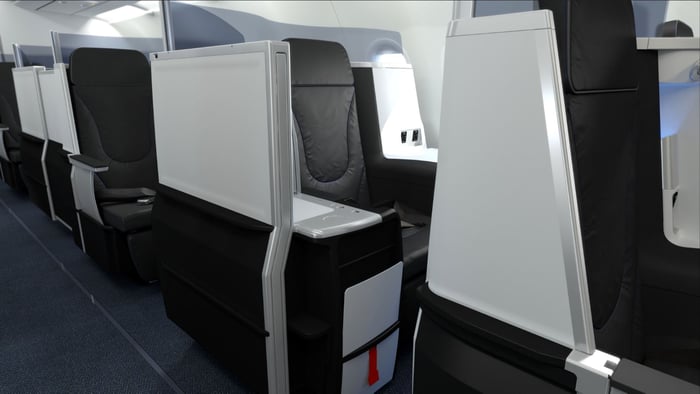After a strong run between 2013 and 2015, shares of JetBlue Airways (JBLU -0.82%) have been stuck in neutral for the past two years. Large increases in non-fuel unit costs and weak unit revenue trends have contributed to JetBlue stock's woes.
However, JetBlue Airways recently raised its fourth quarter unit revenue forecast, following similar guidance increases by several competitors, including Southwest Airlines. This puts the company in position to return to strong profit growth next year, which could propel the stock higher.
Fourth quarter guidance rises
JetBlue wasn't negatively impacted by Hurricane Harvey, because it has virtually no presence in Houston. By contrast, it was hit hard by Hurricane Irma and Hurricane Maria, due to its large footprint in Florida and industry-leading market share in the Caribbean.
Hurricane Maria has had a particularly long-lasting impact on demand, as it destroyed a lot of the infrastructure in key tourist destinations like Puerto Rico. Entering the quarter, JetBlue expected to face a lingering 1%-2% unit revenue headwind from the hurricanes in Q4. As a result, it projected that revenue per available seat mile (RASM) would decline 0%-3% year over year this quarter.

JetBlue's initial Q4 unit revenue guidance was fairly weak. Image source: JetBlue Airways.
However, the impact of the hurricanes on demand has faded faster than management expected. (JetBlue's effort to quickly redeploy capacity from hard-hit Caribbean markets to other vacation destinations also appears to be a success.) Additionally, the fare wars that roiled the airline industry this summer have started to moderate.
The net result is that JetBlue's fourth quarter RASM outlook has improved substantially. The company now expects RASM to be somewhere between down 0.5% and up 1.5% year over year.
Momentum could accelerate in 2018
Even with its improved unit revenue outlook, JetBlue is on track to report a big earnings decline this quarter. Fuel prices are on the rise, while non-fuel unit costs are expected to jump 5%-7% year over year.
Fuel costs will probably remain a headwind in 2018. But non-fuel unit costs should be flattish, due to savings from JetBlue's ongoing structural cost program and easy year-over-year cost comparisons. (JetBlue faced a number of unusual cost headwinds this year related to air traffic control delays and major hurricanes.)
Meanwhile, RASM growth is likely to accelerate. First, the overall industry fare environment seems to be improving. Second, JetBlue is in the midst of dramatically expanding the reach of its upscale Mint service, which has driven strong RASM improvements everywhere it has been rolled out.

Customers have fallen in love with JetBlue's Mint premium service. Image source: JetBlue Airways.
Just since August, JetBlue has added Mint service on three new transcontinental routes: New York-San Diego, New York-Las Vegas, and Boston-San Diego. It will upgrade to Mint service on the Boston-Las Vegas route in January, the Boston-Seattle route in February, and the New York-Seattle route in April. JetBlue also continues to add flights on some of its existing Mint routes.
In total, JetBlue will have 31 Mint aircraft flying by the beginning of next year -- up from 17 a year earlier -- with three more coming in early 2018. That means a much higher proportion of JetBlue's flights will feature this RASM-boosting premium seat offering.
JetBlue stock is absurdly cheap
Surprisingly, JetBlue Airways shares slumped after the company increased its fourth quarter unit revenue guidance. The stock now trades for about 12 times earnings.
JetBlue's valuation ought to be much higher. The combination of its growing RASM momentum and its structural cost program should drive substantial margin expansion over the next few years. JetBlue's upcoming fleet decisions are likely to unlock additional cost savings and revenue growth potential. Finally, the corporate tax cut currently being negotiated in Congress would slash its tax bill dramatically.
During 2017, JetBlue faced a number of unique headwinds, yet it is still on track to earn a solid profit for the year. As it returns to profit growth in 2018, investors may finally start to appreciate its long-term earnings potential. This could send the stock soaring toward new all-time highs.





